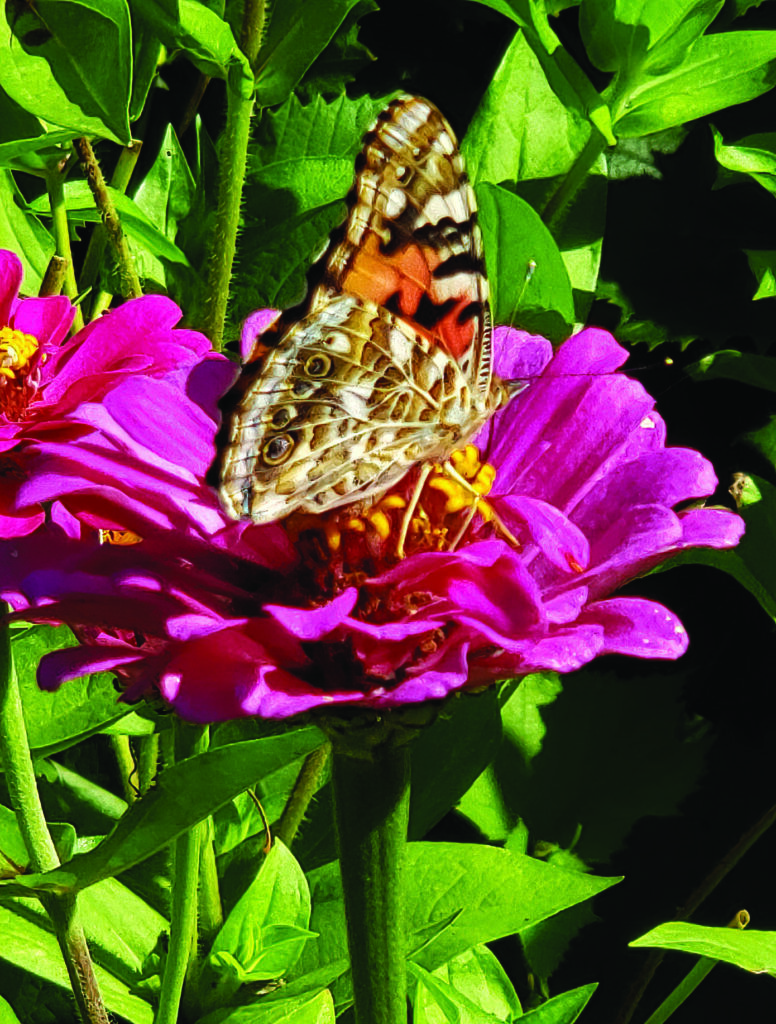
Monarch butterfly perches on a zinnia in a home garden.
Nancy Edmonds Hanson
Consider the pollinators as the growing season slowly springs up across the Red River landscape, it brings the most beneficial moments of the bug year. As bees and butterflies and other insects feed on emerging blossoms and greenery, they do humans the essential favor that keeps us, too, eating: They ferry pollen from one plant to another, fertilizing everything from fields to orchards to backyard gardens.
Just south of what old-timers call the Convent Bridge south of Moorhead, a coalition of groups has turned eight acres of flood buy-out lots along the river into one of the most toothsome tracts a honey bee or butterfly could ask for. The Clay County Red River Pollinator Garden occupies what was once the Crestwood Addition along 60th Avenue South. It sets the pace for a growing movement to support the essential pollen-carrying insects that are being squeezed out by urban development, agricultural chemicals and other environmental factors.
The movement extends from public lands to home gardeners. On May 4 and 11 and again in August, Moorhead Community Education is bringing together some of the pollinators’ local advocates for classes to help urban gardeners learn to plant and nurture the native plants that keep the species well fed and up to the gargantuan task the tiny critters tackle each summer.
River Keepers partners with the Clay Soil and Water Conservation District and its Cass County counterpart to conduct the classes. The first session takes place in a classroom at Probstfield School. For the second, students gather at the restored natural habitat in Crestwood Addition, now in its third year, to see pollinator-friendly principles in action.
“River Keepers loves our native plants,” says Kimberly Morris, who helps lead the class. “With their deep, extensive root systems, they help prevent erosion and in turn flooding. Pollinators prefer native plants as well. It’s a perfect combination.”
The Clay County project offers an example of how solutions to an annoying problem can lead to positive breakthroughs. Commissioner Jenny Mongeau, who serves on the SWCD board, credits a conversation with biologist Tony Nelson – at the time representing Pheasants Forever, now with SWCD – about the tract of barren riverside lots where county buy-out homes had been removed. Due to the use of bonding dollars, they could not be sold to private owners; the county highway department ended up mowing and maintaining the empty tract, which tended to attract rubbish. “It was a nuisance,” Mongeau says.
Nelson brought up a grant program of Pheasants Forever that encourages restoration of native prairie. Once secured, the grant funded purchase of seeds to restore the grasses and wildflowers that flourished here 100 years ago. Other support has come from Minnesota’s Legacy Fund.
The first steps were taken in 2019. Non-native shrubs and trees introduced as landscaping around long-gone homes were removed, along with lawn grass. The area was plowed, then seeded. It was mowed several times that summer and again in 2020, Nelson explains, to discourage weed growth; he expects that to become less and less necessary as the seeded perennial grasses and flowers crowd out the invaders.
Last summer the acres of reintroduced plant life began to blossom – “mostly yellow,” SWCD coordinator Amanda Lewis notes. Among them: black-eyed susans, maximilian sunflowers, purple and yellow coneflowers, purple and while prairie clover, bee balm, common and butterfly milkweed and a mix of native grasses.
Visitors are welcome to walk the pollinator garden, which now extends along the upland portion of the area, with native trees and plants remaining undisturbed on the lower riverbank margin. Besides butterflies, moths, dozens of species of bees and countless less well-known insects, the area is alive with wildlife, from birds and bats and bunnies to deer, foxes and turkeys. All do their part spreading the precious pollen that guarantees good harvests in the fall.
It’s a model that’s spreading far beyond demonstration pollinator plots. Mongeau recounts how the county has adopted the same approach in its regulations for rural solar gardens; the ground underneath the panels must be planted with pollinators’ appetites in mind. So far, five large-scale solar gardens in the county are following that guideline; she predicts more in coming days.
“The benefits of these restorations goes beyond the pollinators themselves,” Lewis points out. “Restoring native prairie supports clean water, soil health and carbon sequestration.” She adds aesthetics and education to that list. “We encourage people to visit and walk around, take pictures and ask questions,” she adds.
And home gardeners are welcome to join the movement. “Any flowers are better than none. More – that’s always best.”
For more information on the Community Education class “Introduction to Native Pollinator Gardening,” visit https://moorheadcommunityed.ce.eleyo.com/


